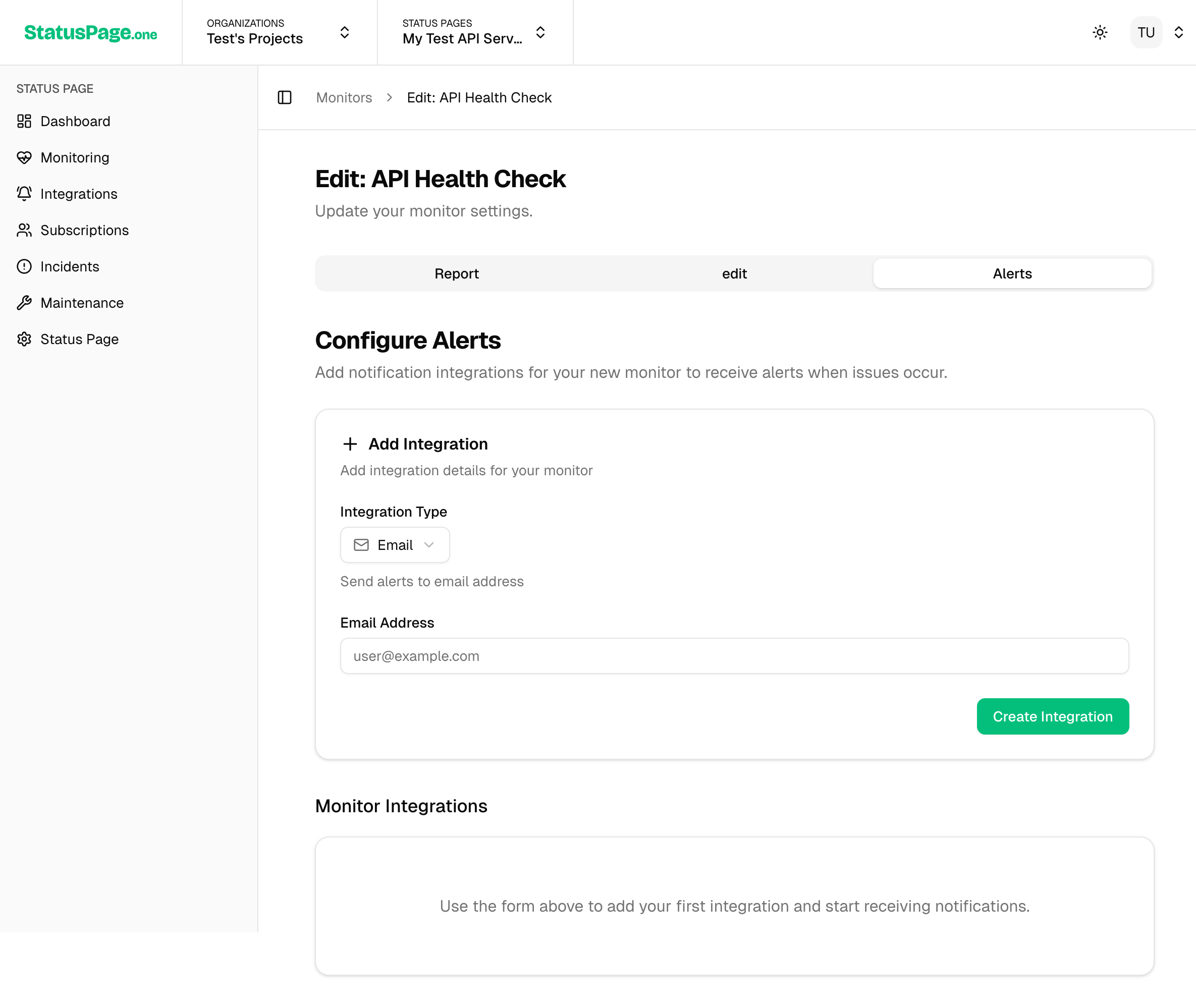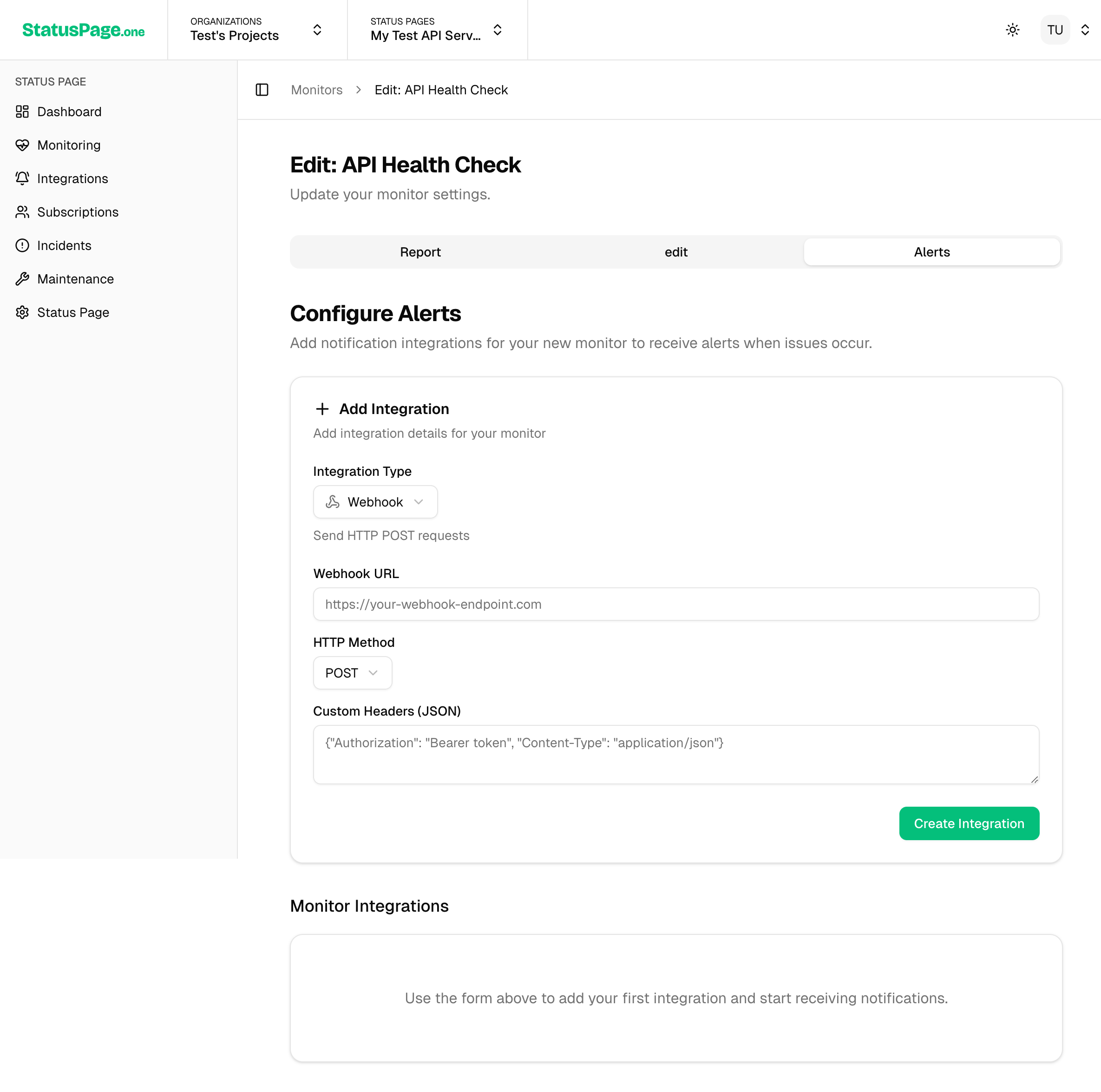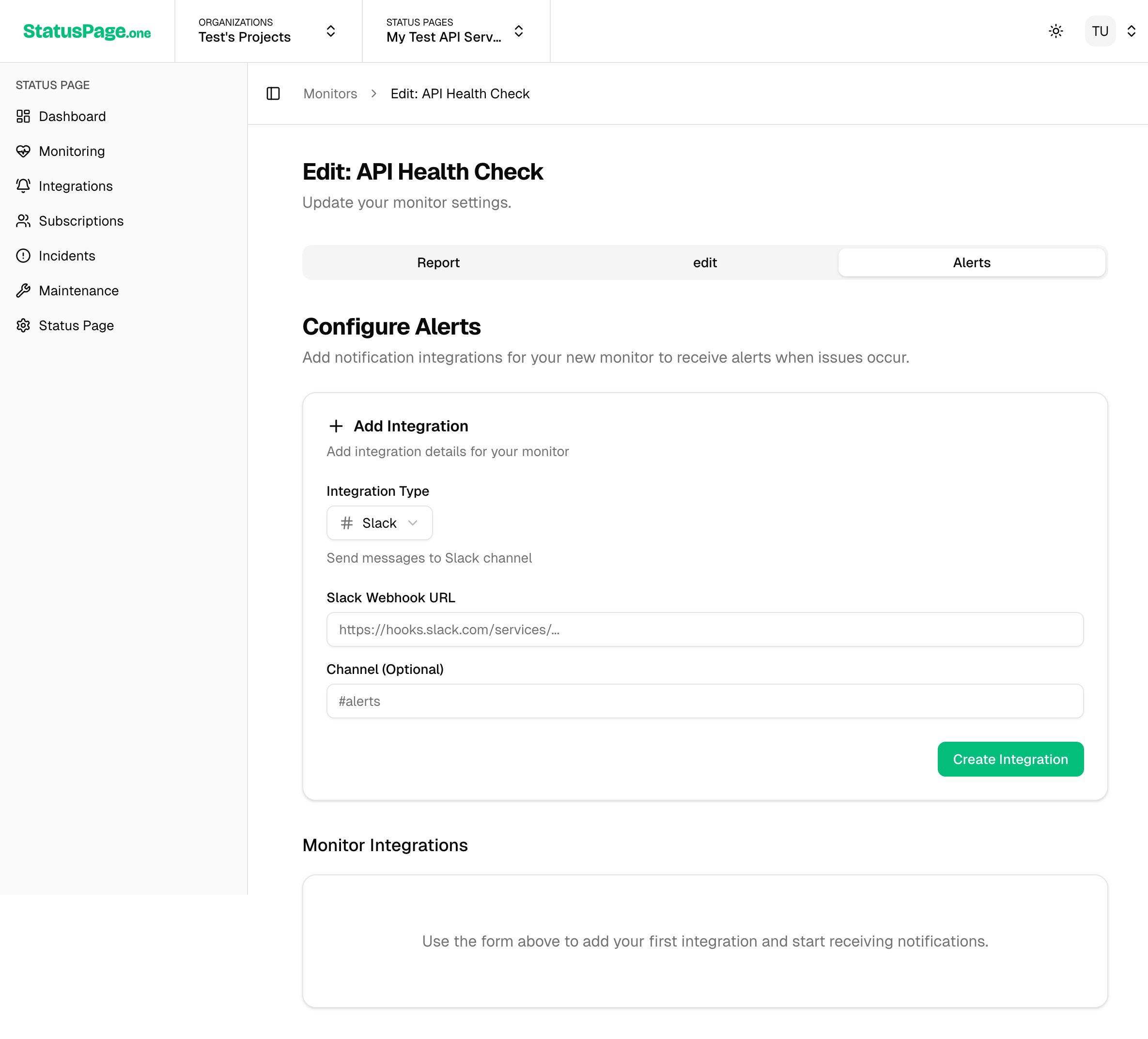Alerting & Notifications
Configure notifications to stay informed when your monitors detect issues
Alerting & Notifications
StatusPageOne's alerting system ensures you're notified immediately when your monitors detect issues. Configure multiple notification channels to guarantee you never miss critical incidents.
How Alerting Works
When a monitor detects a problem, StatusPageOne's alerting system:
- Validates the Issue: Applies retry logic and multi-region validation to confirm the problem
- Triggers Alerts: Sends notifications to all configured destinations for that monitor
- Escalates if Needed: Can send additional notifications for prolonged outages
- Notifies Recovery: Automatically sends recovery notifications when the issue resolves
StatusPageOne minimizes false positives by combining multiple validation methods:
- • Retry Attempts: 0-3 configurable retries before alerting
- • Multi-Region Validation: Confirms issues across multiple regions
- • Grace Periods: Brief delays to allow temporary issues to self-resolve
- • Recovery Detection: Immediate notifications when services recover
Supported Notification Channels
StatusPageOne supports a wide range of notification methods to match your team's communication preferences:


Email Notifications
📧 Email Alerts
Send detailed incident reports and recovery notifications via email.
✅ Advantages
- • Unlimited on all plans
- • Detailed incident information
- • Easy to archive and search
- • Works with any email client
⚙️ Configuration
- • Destination: Any valid email address
- • Format: Rich HTML with incident details
- • Frequency: Immediate + recovery notifications
SMS Notifications
📱 SMS Alerts
Get instant text message alerts for critical incidents.
✅ Advantages
- • Immediate delivery
- • Works without internet
- • High attention-grabbing
- • Mobile-friendly
📊 Usage Limits
- • Free Plan: Not available
- • Pro Plan: 300 SMS/month
- • Business Plan: 2000 SMS/month
Format Required: Phone numbers must include country code (e.g., +1234567890)
Webhook Integrations

🔗 Webhooks
Send HTTP POST requests to your custom endpoints for programmatic handling.
📡 Webhook Payload
{
"event": "monitor.down" | "monitor.up",
"monitor": {
"id": "mon_123",
"name": "API Server",
"url": "https://api.example.com/health"
},
"incident": {
"started_at": "2024-01-15T10:30:00Z",
"resolved_at": null,
"status": "down"
},
"regions": ["us-east-1", "sa-east-1"],
"timestamp": "2024-01-15T10:30:15Z"
}🔧 Use Cases
- • Integration with internal systems
- • Custom alerting logic
- • Automated incident response
- • Data logging and analytics
Team Communication Platforms
StatusPageOne integrates with popular team communication tools:

💬 Slack
Send formatted alerts to Slack channels using webhook URLs.
- Create a Slack webhook in your workspace
- Copy the webhook URL
- Paste it into StatusPageOne integration
🎮 Discord
Post incident notifications to Discord channels.
- Create a Discord webhook in your server
- Copy the webhook URL
- Configure in StatusPageOne
👥 Microsoft Teams
Send alerts to Teams channels via incoming webhooks.
- Add "Incoming Webhook" connector to Teams
- Configure webhook in your Teams channel
- Use the webhook URL in StatusPageOne
✈️ Telegram
Receive alerts via Telegram bot messages.
- • Bot token from @BotFather
- • Chat ID where messages should be sent
Additional Channels
💚
WhatsApp Business
Send alerts via WhatsApp Business API. Requires valid phone number with country code.
Setting Up Alerts
Step-by-Step Configuration
-
Navigate to Monitor Settings
- Go to your monitor in the console
- Click on the Alerts or Integrations tab
-
Choose Notification Type
- Select from the available integration types
- Each monitor can have multiple notification channels
-
Configure Destination
- Enter the required information for your chosen channel
- Test the integration to verify it works
-
Enable the Integration
- Toggle the integration to active status
- Save your configuration
Multiple Integrations Per Monitor
Redundant Alerting Strategy
Configure multiple notification channels for the same monitor to ensure reliable incident notification.
- • Primary: Email for detailed incident information
- • Immediate: SMS for critical incidents
- • Team: Slack/Discord for team coordination
- • Automation: Webhooks for automated responses
Alert Types
StatusPageOne sends two main types of notifications:
Incident Alerts
Sent when a monitor detects a problem and all validation checks confirm the issue.
Information Included:
- • Monitor name and URL
- • Incident start time
- • Error details (response code, timeout, etc.)
- • Affected regions
- • Link to status page
Recovery Notifications
Automatically sent when the monitor detects that the service is working normally again.
Information Included:
- • Recovery confirmation
- • Total downtime duration
- • Recovery time
- • Current service status
Alert Timing & Frequency
When Alerts Are Sent
🔴 Incident Alerts
- • Initial Alert: Sent after retry attempts are exhausted
- • Validation: Only after multi-region confirmation (if applicable)
- • Timing: Within 1-3 minutes of issue detection
🟢 Recovery Alerts
- • Immediate: Sent as soon as service recovery is confirmed
- • Automatic: No manual intervention required
- • Timing: Within 1-2 minutes of service restoration
Alert Frequency Control
StatusPageOne prevents alert spam by:
- Single Initial Alert: One alert per incident start
- No Repeated Pinging: No ongoing alerts for the same incident
- Recovery Confirmation: Single recovery notification per incident
- Rate Limiting: Built-in protection against excessive notifications
Best Practices
🎯 Alerting Best Practices
Channel Strategy
- • Use email for detailed incident documentation
- • Reserve SMS for critical services only (usage limits apply)
- • Configure team channels (Slack/Discord) for coordination
- • Set up webhooks for automated incident response
Alert Optimization
- • Configure appropriate retry counts to reduce false positives
- • Use descriptive monitor names for clear alert identification
- • Test all integrations after setup to ensure delivery
- • Monitor your SMS usage to avoid hitting plan limits
Team Coordination
- • Set up dedicated incident channels in Slack/Discord/Teams
- • Create on-call rotation using different notification channels
- • Document escalation procedures for extended outages
- • Use webhooks to trigger automated runbooks
Managing Integrations
Integration Management
- Enable/Disable: Toggle integrations on or off without deleting configuration
- Edit Settings: Modify destinations and settings as needed
- Delete Integration: Remove integrations you no longer need
- Testing: Test integrations to verify they're working correctly
Integration Status
Each integration shows:
- Status: Active/Inactive indicator
- Last Delivery: When the last alert was successfully sent
- Delivery Status: Success/failure of recent notifications
- Configuration: Current settings and destinations
Troubleshooting Alerts
Common Issues
❌ Alerts Not Received
- • Email: Check spam/junk folders
- • SMS: Verify phone number format includes country code
- • Webhooks: Check endpoint is accessible and returns 200 status
- • Chat platforms: Verify webhook URLs are current and valid
⚠️ Delayed Notifications
- • Retry Logic: Check your monitor's retry configuration
- • Multi-Region: Validation across regions takes additional time
- • Network Issues: Temporary delivery delays may occur
ℹ️ False Positive Alerts
- • Increase Retries: Add more retry attempts before alerting
- • Timeout Settings: Increase timeout for slow services
- • Expected Codes: Verify response code configuration
Usage Limits by Plan
| Notification Type | Free | Pro | Business |
|---|---|---|---|
| Unlimited | Unlimited | Unlimited | |
| SMS | Not available | 300/month | 2000/month |
| Webhooks | Unlimited | Unlimited | Unlimited |
| Chat Platforms | Unlimited | Unlimited | Unlimited |
| Limited | Available | Available | |
| Telegram | Available | Available | Available |
Next Steps
After setting up your alerts:
- Test Your Setup - Verify alerts are working correctly
- Monitor Regions - Optimize monitoring regions
- Status Pages - Create public status pages for your users
Need help configuring alerts? Check our integration guides for platform-specific setup instructions.
Improve this page
Found an error or want to contribute? Edit this page on GitHub.